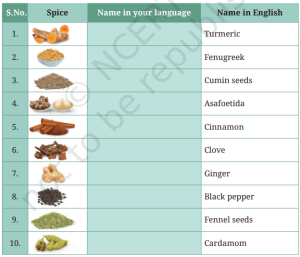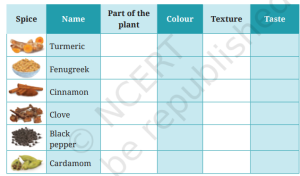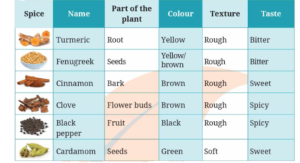Solutions For All Chapters – English Poorvi Class 6
Spices that Heal Us – Part 3
Let us do these activities before we read.
1. A spice is any seed, fruit, root, bark, leaf or any other part of a plant used to give taste and colour to our food. Try to recall the names of three spices that are used for cooking in your home. Write them below and share your answers with your teacher.
(a) _______________ (b) _______________ (c) _______________
Answer:
(a) Coriander
(b) Clove
(c) Turmeric
2. Given below are pictures of some spices. Work in pairs and write what you call them in your language. Their names in English are given in the last column. Share your answers with your teacher.
Answer:
1. Haldi
2. Methi
3. Jeera
4. Heeng
5. Dalchini
6. Laung
7. Adrak
8. Kali Mirch
9. Sauf
10. Elaichi
Let us think and reflect
1. Read the given lines and answer the following questions.
‘When I was a child, I learnt them from my grandmother. She used to find
cures for most of the weather-related common illnesses in the kitchen.’
(a) Where exactly in the kitchen did her grandmother find the cures?
Answer: The grandmother found the cures using spices available in the kitchen.
(b) Give one example of weather-related common illnesses.
Answer: Cough and cold are examples of weather-related common illnesses.
(c) What kind of relationship did the speaker have with her grandmother?
Answer: The speaker had a close and loving relationship with her grandmother
2. Fill in the blanks to complete the sentence.
Daadi soaked methi seeds overnight and drank the water in the morning to manage ___________ and __________.
Answer: Daadi soaked methi seeds overnight and drank the water in the morning to manage sugar levels and body weight.
3. Circle the spice that is not useful for body pain according to Daadi’s letter.
(a) Turmeric
(b) Ginger
(c) Fennel seeds
(d) Black pepper
Answer: (c) Fennel seeds
4. Why did Daadi ask Vikram and Vaibhavi to share the natural cures with their friends?
Answer: Daadi asked Vikram and Vaibhavi to share the natural cures with their friends to ensure that the knowledge of these simple and could get the benefit out of it.
5. What was Daadi’s final advice to Vikram and Vaibhavi?
Answer: Daadi’s final advice to Vikram and Vaibhavi was to remember the natural cures and supervision of elders before using them.
6. How do we know that natural cures are passed from one generation to another?
Answer: We know that natural cures are passed from one generation to another because Daadi learned them from her grandmother and shared them with Vikram and Vaibhavi.
7. Why do you think we should know about the healing properties of spices?
Answer We should know about the healing properties of spices as they are always available in our kitchen and are the easiest and cheapest methods to heal us from common health problems.
Let us learn
1. You have read the uses of spices in the letter. Complete the following table with the help of your teacher. You may use the words from the box given below.
Part of the plant: root/bark/leaves/flower buds/fruit/seeds
Texture: rough/soft/silky
Taste: bitter/sweet/sour/salty/spicy
Answer:
2. Read the sentences given below.
- You may share them with your friends.
- You should try to remember these cures.
- It can help to control cough and cold.
- You must consult an elder before you use them.
- I need to soak the methi seeds overnight.
- I used to put heeng water on your tummy.
(a) The words given in Column A are helping verbs. Match the helping verbs in Column A with their functions in Column B.
| Column A Helping Verbs | Column B Functions |
| 1. may | a. past habit |
| 2. should | b. suggestion |
| 3. can | c. compulsion |
| 4. must | d. advice |
| 5. need to | e. ability |
| 6. used to | f. necessity |
The helping verbs in Column A are called modal verbs or modals. Each modal verb has a different function.
Answer:
1. may – compulsion
2. should – advice
3. can – ability
4. must – necessity
5. need to – suggestion
6. used to – past habit
(b) Complete the following dialogues with any four modals from the table given above. (Use a modal only once.)
Ajay: Anand had a fever last week. He (i) _____________ take good rest.
Suman: Yes, he (ii) _____________ or he will fall ill again.
Ajay: He (iii) _____________ take grandmother’s natural cures.
Suman: Yes, we (iv) _____________ remember how effective they are.
Answer:
Ajay: Anand had a fever last week. He (i) should take good rest.
Suman: Yes, he (ii) must or he will fall ill again.
Ajay: He (iii) can take grandmother’s natural cures.
Suman: Yes, we (iv) Need to remember how effective they are.
Let us listen
You will listen to the benefits of Tulsi (Holy Basil), a common herb. As you listen, complete the factsheet given below. (refer to page 102 for transcript)
Answer:
| The Wonder Herb | ||
| Name | Tulsi | Family: (i) The Wonder Herb |
| First found in | (ii) North Central India | |
| Now found | everywhere in India | |
| Known as | The (iii) Queen of herbs | |
| Can decrease levels of | (iv) glucose and cholesterol | |
| Used to treat disorders of | breathing and (v) digestion | |
| Is used to make | mouthwash and (vi) herbal toothpaste | |
| We can have Tulsi leaves by | eating them (vii) raw or adding them while making (viii) Tea | |
Let us speak
1. Daadi told Vikram and Vaibhavi about many spices. Choose one spice and introduce yourself as that spice to the class.
Answer:
“Hello everyone! I am Turmeric, also known as Haldi. I am a bright yellow spice made from the root of a plant. My taste is slightly bitter, and I have many uses! People use me to add color and flavor to food, but I am also great for healing. I help reduce pain, improve digestion, and boost energy levels. You can find me in many kitchens, and I am often used in cooking and traditional medicine. I am proud to be known as a healing spice!”
2. Before you speak, make a spicy headband for the spice you chose. Follow the steps given below.
Answer:
Steps to Make a Spicy Headband:
- Step 1: Cut out a strip of paper that is about 2 inches wide and long enough to fit around your head.
- Step 2: Join the two ends of the paper strip to make a band that fits snugly around your head.
- Step 3: On a small card, draw or print a picture of your spice (for example, a turmeric root or powder).
- Step 4: Color the picture of the spice and write the spice name underneath it.
- Step 5: Attach the card with the spice picture to your headband.
Let us write
1. Vikram’s grandmother shared two natural cures to cure his cough in her earlier letter. It was kept outside and a few drops of rain fell on it. Some of the words got washed away by the rain. Help Vikram complete the natural cures. Use the phrases given in the box below. There are two phrases that you do not need.
some leaves of basil, for cough, amount of honey, the mixture, for high fever, a piece of fresh ginger, you can have it, grind to get, home remedy
Natural Cures for Cough
(a) To prepare this home remedy, you just need ginger and honey. First, take a piece of fresh ginger, grate it, and take the juice from it. Take about two teaspoons of this juice and add about two and a half teaspoons of honey to it. Mix it properly. Warm the mixture slightly on very low heat for a minute. Then drink it about three to four times a day to get relief from cough. Have patience to see the effect as natural cures made with ginger and honey might take some time to show results.
(b) To prepare the second home remedy for cough, take about 10 grams of each long pepper, dried ginger, and basil leaves. Add four to six small cardamoms and grind into a fine powder. If you take this powder with an equal amount of honey, it will give you relief from cough.
2. Now, write a short paragraph on Tulsi based on the completed factsheet in ‘Let us listen’.
Tulsi, also called Holy Basil, is known as the “Queen of Herbs” for its health benefits. It helps lower blood sugar, cholesterol, and treats breathing and digestion problems. With antibacterial properties, Tulsi is used in mouthwash and toothpaste to cure bad breath. Tulsi leaves can be eaten raw or added to tea to relieve stress. It is a valuable herb with many healing uses.
Let us explore
1. Now that you have read about many spices, can you guess the spices based on the riddles given below?
Answer:
(a) Heeng
(b) Ginger
2. Fill in the blanks to complete the riddle below. Write another riddle of your own and ask your family members to guess the spice.
Answer:
| (a) Brownish- ______ in colour, and bitter to taste, I help everyone, to loose weight. Who am I? Answer: Fenugreek (methi) | (b) I am yellow and brown I am hard, useful in curing aches and pains used as an antiseptic. Who am I? Answer: Turmeric |






Your answer very much good